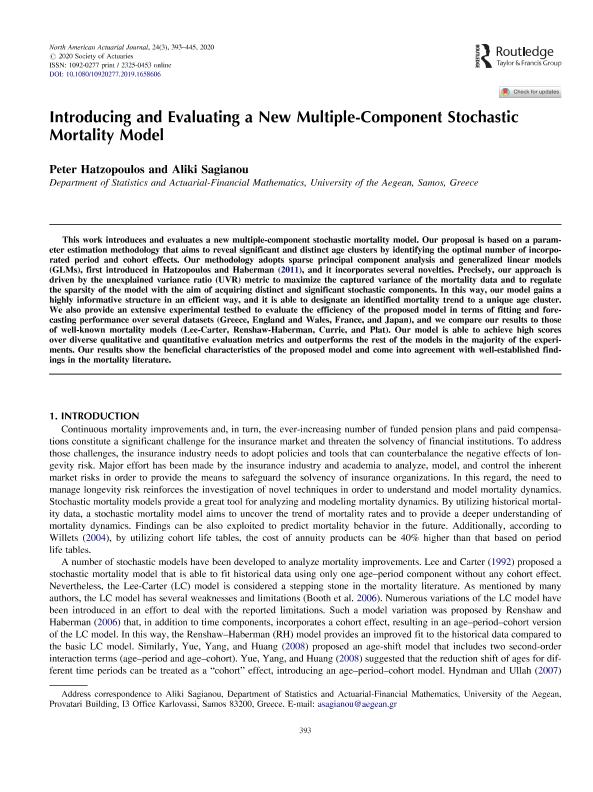Introducing and evaluating a new multiple-component stochastic mortality model

Contenido multimedia no disponible por derechos de autor o por acceso restringido. Contacte con la institución para más información.
| Tag | 1 | 2 | Value |
|---|---|---|---|
| LDR | 00000cab a2200000 4500 | ||
| 001 | MAP20200031543 | ||
| 003 | MAP | ||
| 005 | 20201006140908.0 | ||
| 008 | 201006e20200901usa|||p |0|||b|eng d | ||
| 040 | $aMAP$bspa$dMAP | ||
| 084 | $a6 | ||
| 100 | $0MAPA20200020103$aHatzopoulos, Peter | ||
| 245 | 1 | 0 | $aIntroducing and evaluating a new multiple-component stochastic mortality model$cPeter Hatzopoulos, Aliki Sagianou |
| 520 | $aThis work introduces and evaluates a new multiple-component stochastic mortality model. Our proposal is based on a parameter estimation methodology that aims to reveal significant and distinct age clusters by identifying the optimal number of incorporated period and cohort effects. Our methodology adopts sparse principal component analysis and generalized linear models (GLMs), first introduced in Hatzopoulos and Haberman (2011), and it incorporates several novelties. Precisely, our approach is driven by the unexplained variance ratio (UVR) metric to maximize the captured variance of the mortality data and to regulate the sparsity of the model with the aim of acquiring distinct and significant stochastic components. In this way, our model gains a highly informative structure in an efficient way, and it is able to designate an identified mortality trend to a unique age cluster. We also provide an extensive experimental testbed to evaluate the efficiency of the proposed model in terms of fitting and forecasting performance over several datasets (Greece, England and Wales, France, and Japan), and we compare our results to those of well-known mortality models (Lee-Carter, Renshaw-Haberman, Currie, and Plat). Our model is able to achieve high scores over diverse qualitative and quantitative evaluation metrics and outperforms the rest of the models in the majority of the experiments. Our results show the beneficial characteristics of the proposed model and come into agreement with well-established findings in the mortality literature. | ||
| 650 | 4 | $0MAPA20080586447$aModelo estocástico | |
| 650 | 4 | $0MAPA20080555306$aMortalidad | |
| 650 | 4 | $0MAPA20160001679$aModelos lineales generalizados | |
| 650 | 4 | $0MAPA20080594633$aAnálisis de varianza | |
| 650 | 4 | $0MAPA20080592011$aModelos actuariales | |
| 700 | 1 | $0MAPA20200020127$aSagianou, Aliki | |
| 773 | 0 | $wMAP20077000239$tNorth American actuarial journal$dSchaumburg : Society of Actuaries, 1997-$x1092-0277$g01/09/2020 Tomo 24 Número 3 - 2020 , p. 393-445 |

